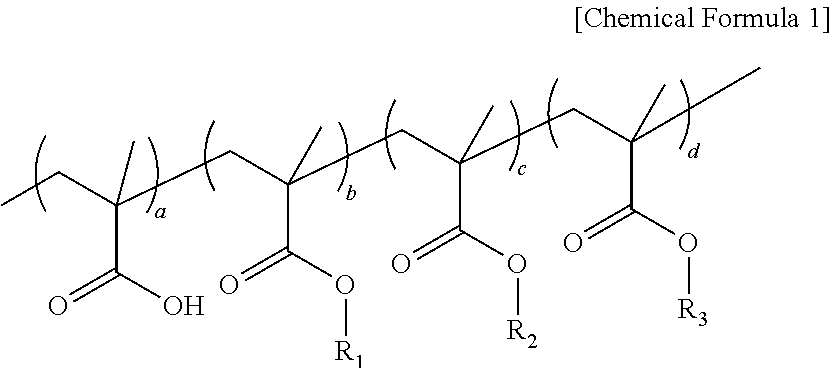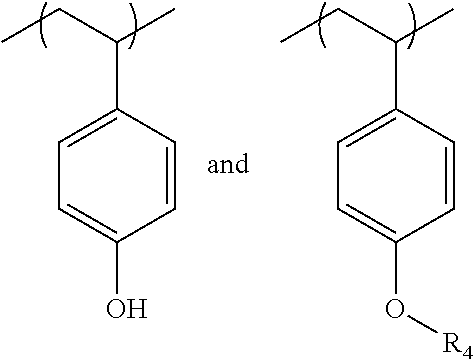Chemically amplified positive photoresist composition for improving pattern profile
a technology of photoresist composition and pattern, which is applied in the direction of photomechanical treatment, photomechanical equipment, instruments, etc., can solve the problems of limited usability in a process based on a light source of 248 nm, unsatisfactory development of next-generation arf photoresists, and low sensitivity of alumina-based photoresists, etc., to improve the solubility of alumina, improve the processing margin, and increase sensitivity
- Summary
- Abstract
- Description
- Claims
- Application Information
AI Technical Summary
Benefits of technology
Problems solved by technology
Method used
Image
Examples
example 1
[0070]A positive photoresist composition for a KrF excimer laser was prepared by mixing 100 g of a phenol polymer resin having a weight average molecular weight of 15,000 (in Chemical Formula 5, R8 is Chemical Formula a, R9 is Chemical Formula c, and respective copolymerization ratios 1, m, and n are 7, 2, and 1) as a base resin, 0.25 g of a transmittance-increasing resin additive having a weight average molecular weight of 17,000 (in Chemical Formula 1, R1, R2, and R3 are methyl, propyl, and butyl, respectively, and respective copolymerization ratios a, b, c, and d are 20, 50, 15, and 15), 4 g of triphenylsulfonium nonaflate as a photoacid generator, 0.6 g of triethanolamine as an acid diffusion inhibitor, and a solvent mixture comprising 104 g of propylene glycol monomethylether and 104 g of propylene glycol methyl ether acetate. The composition thus prepared was applied on a silicon wafer using a spin coater and soft-baked at 140° C. for 90 sec, after which a desired thickness of...
example 2
[0071]A positive photoresist composition for a KrF excimer laser was prepared by mixing 100 g of a phenol polymer resin having a weight average molecular weight of 15,000 (in Chemical Formula 5, R8 is Chemical Formula a, R9 is Chemical Formula c, and respective copolymerization ratios 1, m, and n are 7, 2, and 1) as a base resin, 1.5 g of a transmittance-increasing resin additive having a weight average molecular weight of 17,000 (in Chemical Formula 1, R1, R2, and R3 are methyl, propyl, and butyl, respectively, and respective copolymerization ratios a, b, c, and d are 20, 50, 15, and 15), 4 g of triphenylsulfonium nonaflate as a photoacid generator, 0.6 g of triethanolamine as an acid diffusion inhibitor, and a solvent mixture comprising 105 g of propylene glycol monomethylether and 105 g of propylene glycol methyl ether acetate. The composition thus prepared was applied on a silicon wafer using a spin coater and soft-baked at 140° C. for 90 sec, after which a desired thickness of ...
example 3
[0072]A positive photoresist composition for a KrF excimer laser was prepared by mixing 100 g of a phenol polymer resin having a weight average molecular weight of 15,000 (in Chemical Formula 5, R8 is Chemical Formula a, R9 is Chemical Formula c, and respective copolymerization ratios 1, m, and n are 7, 2, and 1) as a base resin, 25.0 g of a transmittance-increasing resin additive having a weight average molecular weight of 17,000 (in Chemical Formula 1, R1, R2, and R3 are methyl, propyl, and butyl, respectively, and respective copolymerization ratios a, b, c, and d are 20, 50, 15, and 15), 4 g of triphenylsulfonium nonaflate as a photoacid generator, 0.6 g of triethanolamine as an acid diffusion inhibitor, and a solvent mixture comprising 129 g of propylene glycol monomethylether and 129 g of propylene glycol methyl ether acetate. The composition thus prepared was applied on a silicon wafer using a spin coater and soft-baked at 140° C. for 90 sec, after which a desired thickness of...
PUM
| Property | Measurement | Unit |
|---|---|---|
| wavelength | aaaaa | aaaaa |
| molar ratios | aaaaa | aaaaa |
| wavelength | aaaaa | aaaaa |
Abstract
Description
Claims
Application Information
 Login to View More
Login to View More - R&D
- Intellectual Property
- Life Sciences
- Materials
- Tech Scout
- Unparalleled Data Quality
- Higher Quality Content
- 60% Fewer Hallucinations
Browse by: Latest US Patents, China's latest patents, Technical Efficacy Thesaurus, Application Domain, Technology Topic, Popular Technical Reports.
© 2025 PatSnap. All rights reserved.Legal|Privacy policy|Modern Slavery Act Transparency Statement|Sitemap|About US| Contact US: help@patsnap.com



